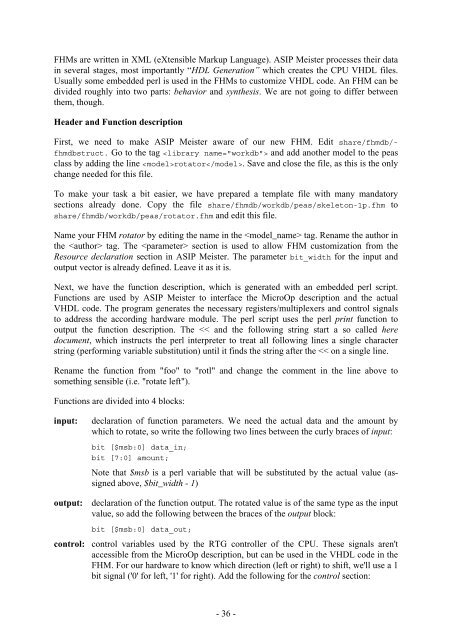Script for Laboratory: Designing embedded ASIPs - CES
Script for Laboratory: Designing embedded ASIPs - CES
Script for Laboratory: Designing embedded ASIPs - CES
You also want an ePaper? Increase the reach of your titles
YUMPU automatically turns print PDFs into web optimized ePapers that Google loves.
FHMs are written in XML (eXtensible Markup Language). ASIP Meister processes their data<br />
in several stages, most importantly “HDL Generation” which creates the CPU VHDL files.<br />
Usually some <strong>embedded</strong> perl is used in the FHMs to customize VHDL code. An FHM can be<br />
divided roughly into two parts: behavior and synthesis. We are not going to differ between<br />
them, though.<br />
Header and Function description<br />
First, we need to make ASIP Meister aware of our new FHM. Edit share/fhmdb/fhmdbstruct.<br />
Go to the tag and add another model to the peas<br />
class by adding the line rotator. Save and close the file, as this is the only<br />
change needed <strong>for</strong> this file.<br />
To make your task a bit easier, we have prepared a template file with many mandatory<br />
sections already done. Copy the file share/fhmdb/workdb/peas/skeleton-1p.fhm to<br />
share/fhmdb/workdb/peas/rotator.fhm and edit this file.<br />
Name your FHM rotator by editing the name in the tag. Rename the author in<br />
the tag. The section is used to allow FHM customization from the<br />
Resource declaration section in ASIP Meister. The parameter bit_width <strong>for</strong> the input and<br />
output vector is already defined. Leave it as it is.<br />
Next, we have the function description, which is generated with an <strong>embedded</strong> perl script.<br />
Functions are used by ASIP Meister to interface the MicroOp description and the actual<br />
VHDL code. The program generates the necessary registers/multiplexers and control signals<br />
to address the according hardware module. The perl script uses the perl print function to<br />
output the function description. The
















